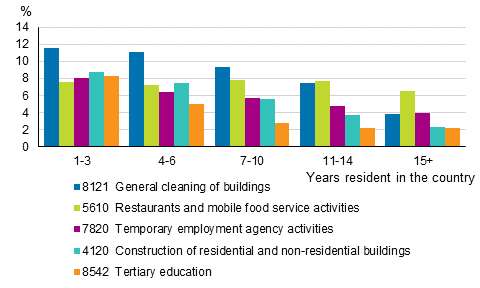Published: 3 October 2019
Most common industry for persons with foreign background was general cleaning of buildings in 2017
According to Statistics Finland's employment statistics, 11,300 persons with foreign background were employed in the industry of general cleaning of buildings in 2017. Around eight per cent of employed persons of foreign origin worked in the industry. General cleaning of buildings has been the most common industry for the population with foreign background since 2010. Examined by groups according to time resident in the country, it was more common to work in the industry among the employed who had lived in Finland for a shorter period.
Most common industries for employed persons with foreign background in 2017
| Industry | Employed persons with foreign background, number | Share of persons working in the industry of employed persons with foreign background, % | Share of persons with foreign background of persons working in the industry, % |
| 8121 General cleaning of buildings | 11,328 | 7.7 | 26.9 |
| 5610 Restaurants and mobile food service activities | 10,696 | 7.3 | 22.3 |
| 7820 Temporary employment agency activities | 8,437 | 5.7 | 14.3 |
| 4120 Construction of residential and non-residential buildings | 7,257 | 4.9 | 12.5 |
| 8542 Tertiary education | 5,366 | 3.6 | 13.1 |
| Other industrues | 104,003 | 70.7 | 5.0 |
| Total | 147,087 | 100.0 | 6.3 |
In 2017, altogether 147,000 persons with foreign background belonging to the population were employed at the end of the year. Every fifth of them worked either in the industry of general cleaning of buildings (Standard Industrial Classification 2008, category 8121), restaurants and mobile food service activities (category 5610) or temporary employment agency activities 1) (category 7820). The highest proportion of persons of foreign origin worked in the industry of general cleaning of buildings.
General cleaning of buildings has been the most common industry for employed persons with foreign background since 2010. Before this, from 2007 to 2009, 2) the most common industry for persons of foreign origin was restaurants and mobile food service activities.
In 2010, altogether 19.1 per cent of those working in the industry of general cleaning of buildings were persons of foreign origin. Seven years later, in 2017, the share was around eight percentage points higher (26.9%). The share of people with foreign background among all employed persons had grown by 2.4 percentage points during the corresponding time period.
Among first generation persons with foreign origin 3) , who accounted for the majority of the working-age population of foreign origin, the most common industry was general cleaning of buildings (11,233 persons). Among second generation persons with foreign origin, the most common industry was temporary employment agency activities (634 persons).
Working in general cleaning of buildings was more common among persons who had resided in the country for a shorter period of time in 2017
In 2017, first generation persons with foreign origin belonging to the population, who had lived in the country for a shorter period of time, 4) worked in the industry of general cleaning of buildings more often than those who had already lived in Finland for a longer period. Of the employed having belonged to the population for one to three years, 11.5 per cent worked in general cleaning of buildings, of those having resided in Finland for at least 15 years, slightly under four per cent (3.8%) of the employed worked in the industry. The employment rate for the first mentioned group was around 40 per cent, for the latter around 60 per cent.
The most common industries for first generation persons with foreign origin vary to some degree by groups according to time resident in the country. For example, the industry of tertiary education (category 8542) is among the five most common industries only when the time resident in the country is one to three or four to six years. However, in all groups, the three most common activity categories among persons with foreign background, that is, general cleaning of buildings, restaurants and mobile food service activities and temporary employment agency activities, appeared among the five most common industries.
The number of employed in the figure’s groups classified according to time resident in the country vary. In the group having belonged to the population for at least 15 years, there were more than 47,000 employed, in the other groups the number of employed was between 20,000 and 30,000.
Share of persons working in the industry* of the employed (first generation persons with foreign background) by time resident in the country in 2017, %

*Most common industries for employed persons with foreign background
1) The industry group of temporary employment agency activities includes both employment agents and those doing temporary agency work.
2) The Standard Industrial Classification 2008 has been used by the statistics since the statistical year 2007.
3) First generation persons with foreign origin refers to persons with foreign background born abroad, second generation refers to persons born in Finland with parents born abroad.
4) Time resident in the country is measured in years when the person has belonged to the permanent population at the end of the year.
Source: Employment Statistics, Statistics Finland
Inquiries: Netta Hiitola 029 551 3552, info@stat.fi
Director in charge: Jari Tarkoma
Publication in pdf-format (212.1 kB)
- Tables
-
Tables in databases
Pick the data you need into tables, view the data as graphs, or download the data for your use.
Appendix tables
- Appendix table 1. Number of employed by origin in the most common industries in 2017 for persons with foreign background in 2017 and 2010 (3.10.2019)
- Appendix table 2. Number of employed and employment rate for the first generation persons with foreign background by time resident in the country in 2017 (3.10.2019)
Updated 3.10.2019
Official Statistics of Finland (OSF):
Employment [e-publication].
ISSN=2323-6825. Background information on unemployed persons 2017. Helsinki: Statistics Finland [referred: 28.12.2025].
Access method: http://stat.fi/til/tyokay/2017/03/tyokay_2017_03_2019-10-03_tie_001_en.html

